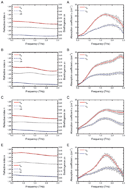Several simple nematic eutectic liquid crystal mixtures composed of different two and three ring isothiocyanato compounds as well as mixtures consisting of analogous cyano and fluoro compounds were formulated. The optical properties of the thereby obtained mixtures, i.e. refractive indices, birefringence and absorption coefficients αe and αo are measured in the frequency range between 0.5 and 2.5 THz and in the visible range at 589 nm. Our results show that two mixtures can be identified, which seems particularly promising for applications in the terahertz (THz) range: those consisting only of isothiocyanates show the highest birefringence at THz frequencies while those consisting of isothiocyanates and cyanides have the smallest dichroic ratio over a broad THz range. We also found that in most cases, the absorption coefficients of the isothiocyanato compounds fulfill the relationship αe > αo while for cyano and fluoro compounds, αo > αe is observed as a dominating trend. Furthermore, we show that by carefully selecting constituents of both isothiocyanato and cyano compounds, we can achieve a mixture for which the values of αo are in the same order as for αe for THz frequencies below 2 THz.

You have access to this article
 Please wait while we load your content...
Something went wrong. Try again?
Please wait while we load your content...
Something went wrong. Try again?


 Please wait while we load your content...
Please wait while we load your content...